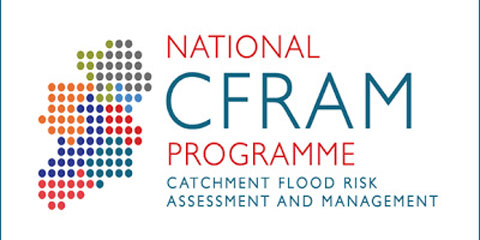A further tranche of draft Flood Risk Management Plans for public consultation for the South Eastern, North Western and Neagh Bann River Basin Districts is now available.
This consultation will run for ten weeks until 28 October, 2016. Consultation is already underway on the draft Plans for Shannon and South Western River Basin Districts which commenced on 15th July.
In the past, flood risk in Ireland tended to be managed in a reactive manner, i.e. measures to deal with flooding were introduced in response to the occurrence of flooding and such measures were generally structural in nature, for example the construction of walls and embankments to contain flood waters.
The Government’s 2004 Flood Risk Policy and the EU Floods Directive in 2007 have changed the focus of dealing with flood risk from being reactive to being proactive.
In 2011, the Government identified 300 areas that are at potentially significant risk from flooding from all flooding sources. Extensive and detailed engineering modelling has been completed for each of these 300 areas, known as Areas for Further Assessment (AFAs). Ninety of these AFAs are coastal areas.
The OPW and its partners has engaged in extensive informal public consultation on the flood maps and the statutory public consultation on the maps concluded in December 2015. The majority of the maps have now been finalised, although some are still undergoing amendment arising from new relevant information being made available. The final maps are also available to view on the consultation website www.opw.ie/FloodPlans.
This consultation on the draft Plans is the final stage of public consultation under the CFRAM Programme. The draft Plans for the Eastern and Western River Basin Districts are due to be available in September. Notices will appear in the national newspapers as the public consultation for each set of draft Plans is launched.
The on-going public consultation process on the draft Flood Risk Management Plans is a significant milestone in the CFRAM Programme. It is very important, therefore, that as many people as possible – local communities, businesses and environmental groups engage in this consultation process. The draft Plans are based on Units of Management (hydrometric areas) and have proposed measures at both community level (Areas for Further Assessment) and catchment-wide level.
Work on mitigating flood risk continues while the CFRAM Programme is being finalised. The Government is providing €430 million for flood risk management measures as part of its overall Capital Investment Plan 2016 – 2021. This substantial increase of over 59% in the level of capital investment provided in the last 5 year programme [2012 – 2016], will allow the OPW to implement flood relief schemes from its current capital programme which are already at an advanced stage of readiness. Already this year the Claregalway Scheme has been commenced, with contractors also on site on schemes in Bandon and Skibbereen. I was in Limerick on Wednesday for the contract signing for the €2.8m scheme in Foynes, Co. Limerick. Before the end of the year, works are expected to commence on projects at Northlands, Co Meath and on the Dunkellin River in County Galway. In 2017, the first phase of works on the largest flood relief scheme ever to be undertaken in the State are expected to commence in Cork City, along with schemes in Blackpool and Clonakilty in County Cork, Templemore, Co Tipperary and Enniscorthy, Co Wexford.
The Capital Investment Plan will also allow the OPW to continue the design and planning work for flood relief schemes in the pipeline such as for Arklow, Co Wicklow, Raphoe, Co Donegal, the King’s Island phase of the Limerick scheme, the River Poddle, Dublin and Crossmolina, Co Mayo. Work on the development and progression of a scheme for Athlone by Westmeath County Council is also now underway. The estimated future cost of the current programme is in the region of €350 million. In addition, and importantly, the enhanced investment programme will enable the OPW, in collaboration with the relevant Local Authorities, to begin the process of preparation and planning for the structural works and schemes that are expected to be recommended under the CFRAM Plans.
In addition, I am chairing an Interdepartmental Committee that is developing for Government the whole of government policies and measures to support the Flood Risk Management Plans, to help individual and communities prepare, plan and protect their lands, properties and communities from flood risk. Some of the policy areas being considered are insurance, planning and development guidelines, community resilience and individual property protection. I urge everyone to consult the website or call into their local authority offices and give their comments on the draft Plans.
Further tranche of flood risk plans for public consultation
By Seán Canney|
2017-01-18T09:20:00+00:00
August 22nd, 2016|Blog, Farming, Flood Relief, Homepage, Latest News, National, O P W|0 Comments
Related Posts
Leave A Comment Cancel reply
You must be logged in to post a comment.





